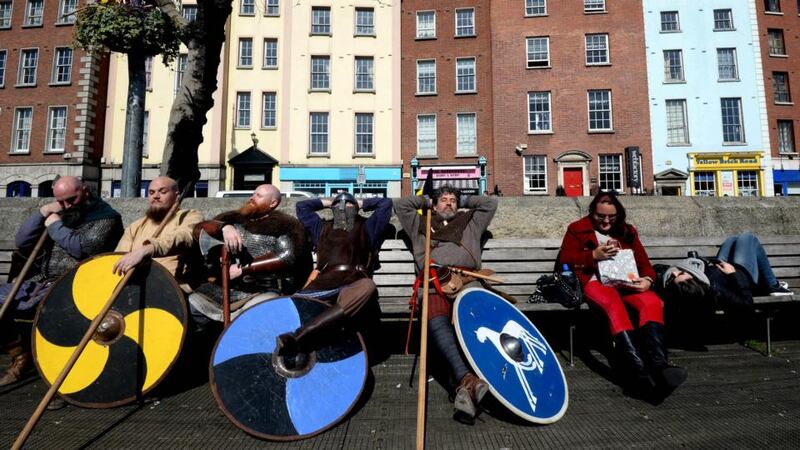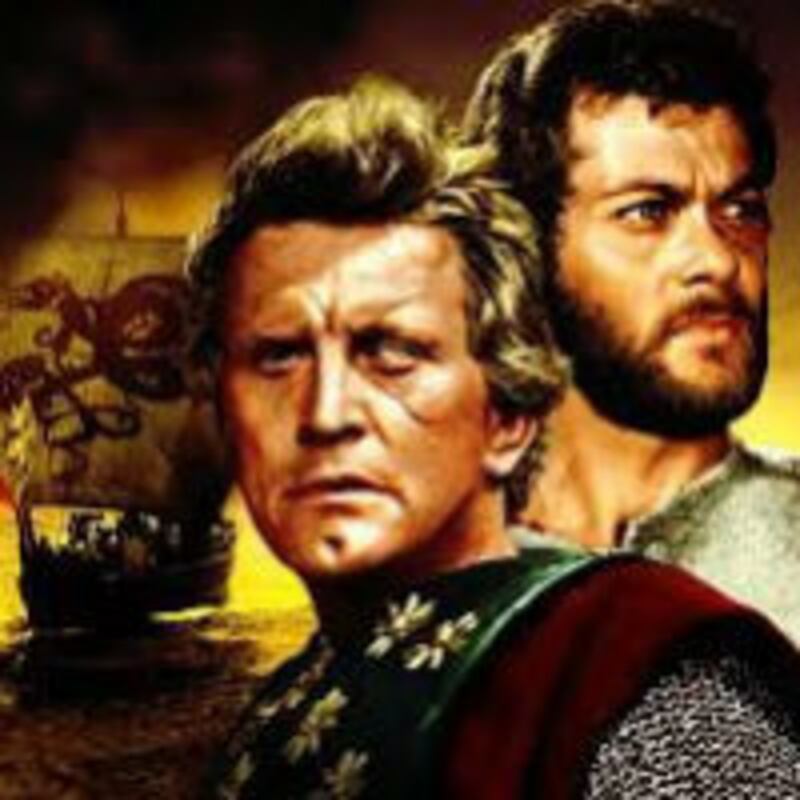It is a scene familiar from every primary-school history book. A horde of long-haired, sword-wielding, fearsome-looking foreign marauders run amok in a peaceful Irish settlement, desecrating a primitive church, terrorising the congregation and making off with gleaming Celtic crosses.
This is not some episode recounted in a dusty medieval chronicle, however. Rather, it is a snapshot of contemporary Ireland, from the set of Vikings , the hit historical drama series, two seasons of which have been filmed with visceral verisimilitude in Co Wicklow since 2012.
From books to comics, music to movies, blockbuster exhibitions to popular attractions, Vikings have never seemed so woven into our consciousness, be it cultural or historical. A thousand years after they were supposedly vanquished by Brian Boru, the Vikings are back.

Much of this revival of interest is of course rooted in the 1,000th anniversary of the Battle of Clontarf, as institutions and artists mark the clash that saw Boru’s Christian Irish army defeat the pagan Norse led by the magnificently named Sitric Silkenbeard.
Among the many official millennium celebrations, the National Museum of Ireland is hosting the exhibition Clontarf 1014 , while Dublin City Council is recreating the battle at St Anne's Park in Raheny with the help of various historical re-enactment societies today and tomorrow. Other events will take place from Armagh to Tipperary. Meanwhile, Clannad singer Moya Brennan and harpist Cormac De Barra are premiering and touring Ten14 , a music show about Brian Boru's life, for families and children. And Dublin continues to have perennially popular Norse-themed tourist attractions such as as the Dublinia "living history" museum and the Viking Splash Tour.
Outside Ireland, the trend continues. In London, the British Museum is attracting large crowds to Vikings: Life and Legend , the institution's first major exhibition on the subject in more than 30 years. All the while, the television series Vikings has been earning substantial fan bases across the world, from the US to Australia and even Scandinavia.
Zeitgeist
"The show's success kind of confirmed my suspicion that the Vikings are in the zeitgeist," says Michael Hirst, the television drama's creator, who originally became interested in them as potential screen fare in the late 1990s. "I put the material in my back pocket and waited for someone to ask me to make it. When I mentioned it to people back then, there was very little interest. But now when I tell people the show is being made, they go, 'Wow, I can't wait to see that'."
How all this activity relates to the reality of the Viking world is another matter. Ever since the 19th century there have been periods when Norse history and culture have been in vogue, but in the past, these surges of interest have said more about their own era than about the fabled Scandinavian raiders who left their mark across Europe and beyond.
Certainly, the popular Irish image of the Vikings as rampaging intruders who were finally expelled on Good Friday 1014 is misplaced. For one thing, they never really went away.
"If you ask the question, 'What happened to the Vikings after Clontarf?', the answer is 'Nothing', " says Dr Andy Halpin of the National Museum of Ireland. "They stayed, they're still here and a lot of us probably have their blood in our veins."
On one level, this is purely a matter of historical accuracy. The two armies that faced each other at Clontarf were both composed of native Irish and Viking combatants: Silkenbeard, whose mother was Irish and who lived on in Ireland for another 22 years after his defeat, was one of the intermarried “Hiberno-Norse”.
"It wasn't some nationalist struggle to drive the foreigners out," says Halpin. "The last thing Brian Boru wanted to do was drive the Vikings out." Rather, he wanted to control them and the pivotal port town they had founded. Hence the subtitle of the National Museum's show: Brian Boru and the Battle for Dublin .
But while the Hiberno-Norse were gradually absorbed into Gaelic society, the perception of them as repellent – and repelled – foreign invaders had been established. Much of this was down to the biases of our primary historical sources. The primary chroniclers of the era were monks based in the early Christian monasteries that were disproportionately targeted by Vikings, leading to an understandably jaundiced portrait of the heathen raiders. The main account of Clontarf, actually written decades after the battle, had a similar effect.
These myths were reinforced in the popular mind by such famed sites as the round tower at Glendalough. The portrayal of such structures as refuges from longboat-borne raiders is, says Halpin, “a complete 19th-century construction”.
In Victorian Britain, the Vikings again proved a handy blank canvas for contemporary attitudes. "Figures like William Morris and Thomas Carlyle paint the Vikings as proto-British," says Tom Williams, project curator of the British Museum exhibition.
“It’s all about seafaring and the adventurous spirit, and bolted on to that is the mentality that the Germanic people invented democracy; that they’re freemen establishing parliaments.”
"The Vikings are seen as rebels," says Sheila Dooley, the curator at Dublinia, which has traded on the capital's Viking history to formidable effect, attracting 150,000 visitors in 2013.
“They’re renegades, they’re warriors, they have fantastic weapons, they have this way of life that was a bit more risqué. And I suppose that’s attractive.”
Williams concurs that such preconceptions help even when staging a meticulously researched exhibition such as the courrent show at the British Museum. "We're fortunate that we can put on this exhibition and know there's this preloaded sense of what a Viking is, whether that's right or wrong, and immediately be excited and engaged." The downside of this, Williams says, is that some people complain about the absence of horned helmets, another Victorian fabrication.
Breeding legends
The enduring appeal of Vikings also lies in the richness of their mythology. "It's not only their material culture but their written culture that has caught people's imagination," says Dooley. "The Vikings themselves liked myth, and they were breeding their own legends."
The Norse pantheon of gods continues to resonate. Thor, the god of thunder, has been resurrected for modern audiences as a Marvel Comics character since the 1960s and, latterly, as a celluloid hero in the big-budget screen adaptations. Meanwhile, Norse beliefs are central to the characters and narrative of the television drama Vikings : the Huffington Post called it "one of the few mainstream shows to take religious belief seriously", which may account for its high ratings in America's Bible Belt.
In Ireland, however, there is a more complex relationship with the Viking past in play. This is rooted in 19th-century preconceptions that viewed Brian Boru’s victory through the prism of the struggle against British rule. This interpretation of the Viking as an expelled foreign oppressor, Halpin says, was “pushing against an open door”: witness Daniel O’Connell’s symbolic choice of Clontarf as venue for his (fatefully cancelled) Home Rule monster meeting of 1843.
That notion had a crucial, and calamitous, effect on independent Ireland’s treatment of its cultural and historical heritage. From the early 1960s on, archeological finds from the early Norse settlement at Dublin’s Wood Quay seemed to herald a fresh mindset, influencing a wider movement of international scholars seeking to recast the Vikings’ image. “It was as the result of excavations in York and Dublin in particular that people started to realise there was this other side to Viking life, of craftsmanship and trade,” says Williams.
But there was an ambivalent attitude towards the artefacts being uncovered at Wood Quay. “The National Museum pumped enormous resources into the excavations,” says Halpin, “but there was also this sense in some quarters of the organisation that there may be fabulous archeology there, but it’s not ours: it’s foreign.”
This attitude fed into Dublin Corporation’s decision to build its monolithic Civic Offices on the Wood Quay site.
It was a shameful episode, but also a crucial turning point. For one thing, says Halpin, “It forced officialdom to pay more attention to heritage matters”, to the point that the country’s historical sites are now deemed vital national assets, if partly because of their potential for cultural tourism.
This new awareness fed into the popular imagination in a surprising way, with Dublin’s Viking roots becoming a key element in the capital’s sense of identity, from the city’s millennium celebrations in 1988 to, yes, the rowdy Viking Splash Tour.
“Thirty years ago Dublin was a tourism black spot, whereas today it’s probably the major tourist destination,” says Halpin. “And its heritage is a major factor in that, from Dublinia to Christ Church.”
There is a certain irony that more than 1,000 years after they arrived in Ireland to plunder its goods, the Vikings should now be attracting visitors here.
For its part, the British Museum’s absorbing show harks back to our folk memories of the warriors from the north. With striking artefacts including a jawbone of fearsome filed teeth, slave shackles (from Ireland) and a mass grave of beheaded Norsemen, it’s a jolting reminder of the fearsome reputation that, in the end, has ensured the Vikings’ place in our culture.
“You have to remember that the word Viking itself means ‘raider’,” says Williams. “And you can’t really be a Viking if there isn’t a little bit of bloodshed involved.”
Vikings in popular culture - Four of the best

The Vikings (1958)
This Hollywood epic focused on two long-lost half-brothers, played by Kirk Douglas and Tony Curtis, who battle for the throne of an English kingdom – and the attentions of Janet Leigh. Pleasingly full of lusty dialogue, sword-clashing action and rugged costumes.
 Asterix and the Normans (1966)
Asterix and the Normans (1966)Confusingly titled and historically anachronistic it may be, but the comic-book encounter between the indomitable Gaul and the fearless visitors from the frozen north is a typically enjoyable romp, later made into the 2006 animated feature.
 Immigrant Song (1970)
Immigrant Song (1970)Written while on tour in Iceland, Led Zeppelin’s ode to those from “the land of ice and snow” is full of cod-Norse hokum, from “the hammer of the gods” to the battle-cry of “Valhalla, I am coming”. It also rocks righteously.
 Anchorman (2004)
Anchorman (2004)Ron Burgundy: “Great Odin’s raven!” Enough said.











